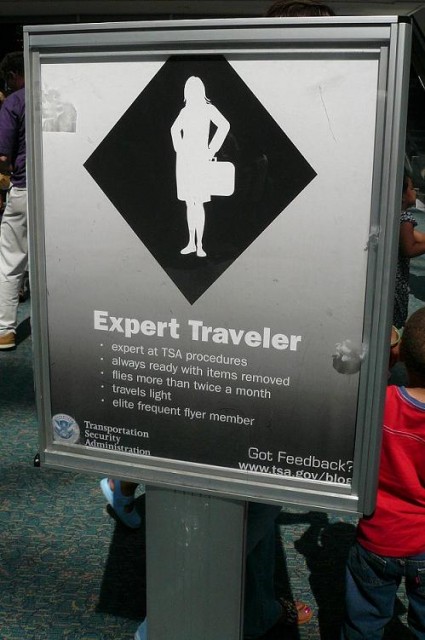
TSA Expert Traveler Podium – Photo: Michael Gray | Flickr CC
I was recently invited to sit down with a local news outlet to discuss TSA’s Pre ✓™ program from the perspective of a frequent flyer who hadn’t signed up, and questions its utility as the program stands today. To be clear, I do not see the program as a threat to security. Instead, the program’s benefits simply aren’t compelling enough for me to part with $85 and take the time to be interviewed and fingerprinted.
$85 isn’t unreasonable, and there is even an interview site here in my Kansas City suburb. The idea of fingerprinting and background checks don’t bother me either since I’ve been through both as a basis for employment.
Instead, the “gotcha” for me is the fact that while having never signed up for TSA Pre✓™ I have experienced it first-hand many, many times, and I’m just not convinced on its utility to me as a semi-frequent traveler. But why? It comes down to what I like to call the “TSA Pre✓™ dilemma.”
In preparation for my news interview, I wanted to check my facts so I called Ross Feinstein, Press Secretary for the Transportation Security Administration. The TSA claims Pre✓™ is quicker, with faster moving lines. In theory, and even sometimes in practicality, that’s likely right. According to Feinstein, expedited screening lanes should be able to process 260 passengers per hour, over 70% more than the 150/hour in standard lanes.
Opposing opinion: TSA Pre Check: What Is It & Why You Want It
I first read about the program back when it began as a pilot in late 2011 and thought it was a great idea: Shorter lines, and I could keep my shoes and belt on, without having to remove my laptop and toiletry bag. Pure laziness prevented me from signing up as it exited the pilot phase and continued to roll out to additional airports. Then, one day in 2012 while standing in a long screening line at Phoenix Sky Harbor Airport (PHX), I was approached by a TSA agent and told to move to a different lane.
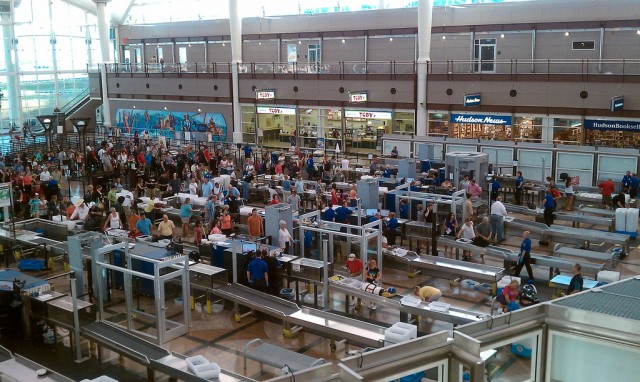
Long security lines at Denver International Airport – Photo: Quinn Dombrowski | Flickr CC
That lane, I would later learn, was for Pre✓™ passengers and at the time was being underutilized. The TSA was diverting non-Pre✓™ passengers into the expedited lane in an effort to relieve the standard screening line and speed things up. I recall being excited to have been picked for what I would consider a complimentary preview. The excitement didn’t last, however, as I was randomly selected for an explosives trace detection (ETD) swab a total of three times.
My third and final swab was just as I was exiting the metal detector. This time each of the ETD machines needed to be calibrated, all at once. I distinctly remember watching the standard screening line continue on as I stood there waiting for at least one of the machines to finish calibration so I could be on my way.
While my first experience wasn’t ideal, I remained committed to the idea of expedited screening. The program was new and very obviously there were bugs; bugs I figured that would work themselves out given time. Over the next two years, I would be selected for expedited screening either via a “wave in” or by receiving Pre✓™ on my boarding pass. In most scenarios my experience did not meet expectations.
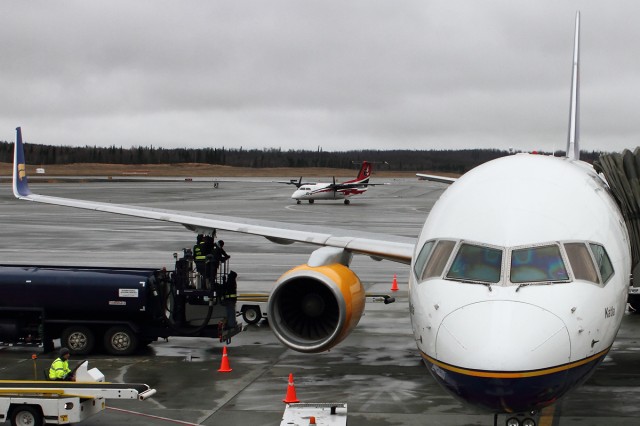
All most passengers want to do is get to their gate and on their plane quickly – Photo by Brandon Farris | AirlineReporter
The TSA Pre✓™ dilemma is multifaceted
Over the three years since inception, enrollments have been lackluster. “We need a bigger base,” said Feinstein. To offer a preview of the program, as well as relieve pressure on non-expedited lanes, the TSA uses a number of risk-based assessments they refer to as “managed inclusion” to allow non-known travelers access to expedited screening.
Managed inclusion, in theory, should be a win-win for most. It better distributes workloads, is more cost efficient given reduced overhead, and most importantly it potentially encourages signups. One group, however, doesn’t benefit, and that is the group of travelers who have actually invested the time and money to participate in the program. This occurs more often than not in my experience: Infrequent travelers find themselves in the expedited lane, confused about the process, and compromise efficiency.
The second part of the TSA Pre✓™ dilemma is one of marketing. The TSA is missing a significant opportunity to help to improve the narrative on all fronts. I have never once seen an advertisement for TSA Pre✓™ and it seems all of the media coverage on it is negative, calling into question security issues, but more on that in a moment. Each day a staggering 40% of U.S. travelers receive expedited screening, with a large potion of that being through managed inclusion.
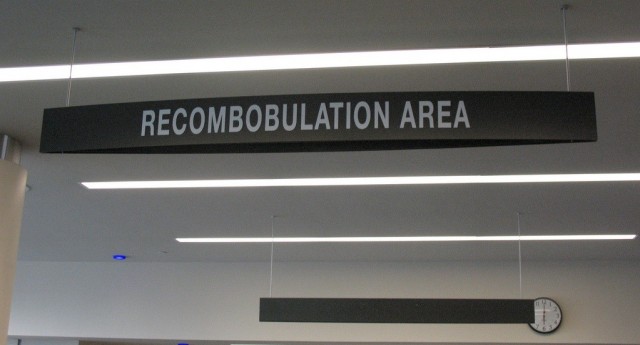
Recombobulation area seen just past the TSA checkpoint at Milwaukee’s General Mitchell airport. Photo: Celia | Flickr CC
What an excellent opportunity to not only offer the preview, but also educate those who are outside of the program. Yet there are no pamphlets, no flyers, not even business cards with a message defining the program and inviting travelers to learn more at TSA.gov. Instead, confused travelers find themselves in an expedited line, stumble through the process and go about their day likely still confused while having received no marketing or call to action.
The final pillar to the TSA Pre✓™ dilemma is one which receives far too much attention: Perception of an inherent security flaw with the program, most often in the context of managed inclusion. To my sincere dissatisfaction, the local news piece which I had involvement in focused on this almost exclusively. Fear-inducing previews like “some passengers have been able to skirt routine security measures” and “could a snap decision at the airport jeopardize your safety?” are abundant and, in my opinion, reckless and misguided.
What’s the biggest threat to an airplane? A knife? A pistol? While these items can be dangerous, with hardened cockpit doors installed after 9/11, an improvised explosive device poses the biggest threat to aviation security today. – Blogger Bob, TSA Blog Team
While the TSA readily admits knifes and guns are not the biggest threat to security, they continue to tout each find they make. As a result, they directly contribute to the perception that small weapons are the primary concern. If that is the perception then it’s reasonable that the general public would be skeptic of allowing for expedited screening of those who haven’t been vetted with background checks.
MT @TSAmedia_RossF: As of right now, 1,872 firearms discovered in carry-on bags in 2014. http://t.co/w3WK7ZTrd5 pic.twitter.com/RxWys5I5wl
TSA (@TSA) November 7, 2014
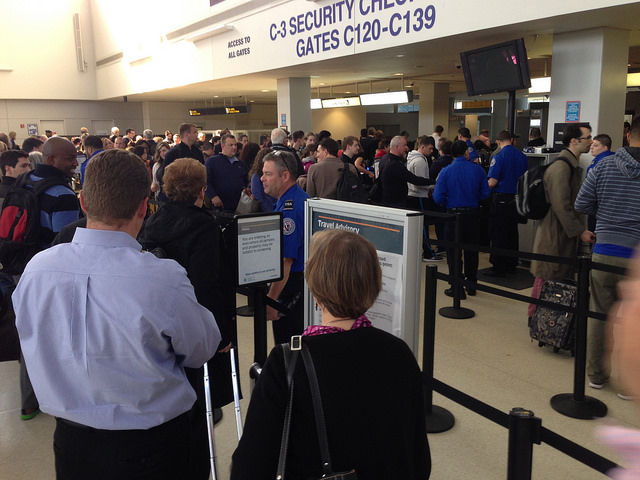
Here is a Pre✓™ lane at Newark, where it still took passengers 30 minutes to get through – Photo: Wayan Vota | Flickr CC
Of course, we hear a lot about managed inclusion being random. “It’s not random,” says Feinstein, “It seems random to travelers [but it’s] intelligence based.” He explained that those who the receive TSA Pre✓™ on their boarding passes do so as the result of a proprietary algorithm which takes into account the individual traveler, threat levels between city pairs, and a number of other variables that for security reasons aren’t discussed.
But what about “wave ins” – that is, those who were not selected ahead of time, but are diverted from the regular lines into expedited screening? Feinstein explained that those at times have a random element but suggested there is often is more at play than meets the eye. TSA documentation on managed inclusion indicates that the practice includes the use of behavior detection officers as well as increased use of ETD and dogs.
I will continue to accept Pre✓™ privileges when I get them, but until the agency is able to attract enough experienced, paying customers or they bring an end to diversions I’m okay with standard screening. I’ve removed my laptop and shoes a number of times each month for over a decade now and I’m used to it. Plus, thanks to Southwest’s Fly By® Priority Lane benefit, I’m typically able to get through security quicker than even those in the Pre✓™ lane.
Oh, and that news interview which was the catalyst for this post? Here’s a link; just don’t believe everything you see on TV.

TSA security procedures are just a ritual, and have nothing to do with real security. And to expect nothing bad to ever happen to an airplane full of people again is completely UNrealistic.
Susan, you are completely correct in your statement. The Terrorizing Sexual Assault (TSA) is all about the illusion of security theater. Their job is to give the appearance of security and make most of the idiots that fly infrequently and know no better feel safe, but in reality, it is just a show that is as solid as a block of Swiss Cheese. At this point we really need to return to sanity, end the fear mongering, end the TSA and all the other post 9/11 garbage. 9/11 was a lie and the TSA was formed on that lie.
Ian, when I read your comment “9/11 was a lie” your problem became quite obvious: That extra-large tin foil hat you wear likely sets off all the security alarms in the area…
Mike,
You really believe the official story? Go back to Sheep.
I don’t have a problem with PreCheck, and in fact love it. At IAD it routinely saves 20 minutes or more versus the regular line, especially on busy travel days. On a recent trip through SEA, I managed to get from the ferry dock downtown to my gate in 40 minutes. The regular line was miles long, typical SEA fashion.
For $85 you can get PreCheck but for $15 more you can get Global Entry and PreCheck – which is of way more value for me as most of my travel is international. Even if most of my travel was domestic, I’d still opt for Global Entry b/c it just seems smarter.
I wish that TSA played better with foreign partners so I could go through the expedited lane in Frankfurt (or avoid a second check altogether).
As for the comment that TSA is a lie or theater – agree a certain amount of it is. The 3oz rule is arbitrary and silly. Taking your shoes off is also silly. What does work is having a single organization that is able to consume intel from the IC and then translate it down to the practical level (interacting with passenger and airlines) is a valuable improvement from pre-9/11 systems.
Overall as a frequent traveler that knows the rules, travels light, and would prefer to avoid spending 2 hours at an airport I appreciate it right along with upgrades and lounge access.
Hi Andy. Thanks for the comment. And I agree. The international known traveler programs are very attractive, plus managed inclusion doesn’t exist in customs lines. The vast majority of domestic travelers however don’t go abroad so for length reasons I left that part out. Glad to hear you have had a positive PreCheck experience, though. The program has promise in the long run.
Like many others I access PreCheck via my Global Entry membership, which has paid for itself many times over. I don’t even care that the PreCheck lines are usually (much) shorter than the normal lines; the big benefit for me is that it has drastically reduced my confrontations with the TSA, an agency I hate dealing with. I agree with the other commenters that they are all about security theater. With PreCheck at least I can play my correct role in this production as a non-threat and breeze through the checkpoint.
One clarification for your piece: While PreCheck has been around for several years, it was initially only accessible through Global Entry (and similar programs) and via airline invitations (typically to elite frequent flyers). Direct enrollments with TSA began about a year ago.
I’m not using it because in our family just 2 of 4 are TSA Pre approved.
My older daughter approved but younger doesn’t.
Weird but true.
First, calling the TSA “Terrorizing Sexual Assault” is moronic. It’s not helpful. They are trying to a do an impossible job – screen everything so that there is zero, ZERO chance that anything gets through, and do it without holding anyone up, do it without profiling, and do it without making anyone feel that their personal space is invaded.
You try to do that.
As a very frequent flier, I appreciate the TSA. All I ask is that they have adequate staff, plan for busy days (Midway Airport Sunday this week is an example of a failure at that), and that they have clear expectations of what is allowed through the checkpoint.
PreCheck is nice, but it is becoming overused. At DFW Airport yesterday, the PreCheck line was far longer than the main line, because so many people use it. But it does its job – get more people through quickly, and allow the tighter screening for people that could be a bigger threat.
It’s worth having it even if you use the regular line, because you don’t have to remove your shoes or go through the imager. They call this “expedited security”, and it alone is still worth having PreCheck.
PS to Ian. People who doubt 9-11 are, sorry to say, fools. Here’s why. Do you have any idea of the number of people it would have taken to do that on purpose? Then they all have to stay quiet. The idea that so many people would be involved in murdering thousands of people and none of them would have said anything is ludicrous.
Put the tinfoil hat away and stay away from the conspiracy websites.
I agree with the comments that the TSA is security theater.
I was leaving IAD one Friday afternoon and as usual the security lines were insanely long. To move the lines along, the power that be decided that all checkpoints would follow the PreCheck rules.
If an entire airports worth of people are ok to follow the PreCheck rules, they should just be used everywhere. Use the super secret intelligence software to select the high risk passengers for additional screening.
I am extremely disappointed that anyone would either willingly pay money to the TSA or be upset at the proposition that they have less intrusion into our lives. Fvck the TSA and all it stands for.
I travel weekly and have come to really appreciate Pre Check mainly because it’s far easier than taking off your shoes, belt, coat, pulling out your laptop and toiletries and because you don’t have to go through the potentially cancer causing imaging scanners.
I also like that you can bring kids 12 and under through Pre-Check with you if you happen to be traveling with your family. One trick we use with our 12 and 10 year olds is to split them up with my wife so I take one kid through pre-check and my wife takes the other through normal security (you don’t have to go through the imaging machines if you are with a child). 100% of the time, my son and I get through security faster via pre-check than my wife and daughter do, so in my experience, it is always faster.
I don’t like how they invite others in to the Pre-Check lanes though since they typically are confused and start undressing which just slows everything down. On top of that, they didn’t pay for it, so it’s a bit of a slap in the face to everyone else who did pay and went through the process.
One other tip that most people don’t know is that if you have NEXUS (Canada’s entry program), which only costs $50 for 5 years, you get Global Entry and Pre-Check free. The downside is, you have to go interview with the Canadian Border Patrol at an airport in Canada or at a border airport. If you do travel to Canada though, it’s the cheapest way to get all 3 programs.
Lastly, they now accept Global Entry in foreign ports like Australia and New Zealand so it is possible to breeze through Customs on international travel depending on where you are going. I’ve also heard they are going to expand this to other countries in 2015.
You have to wonder about TSA profiling. Right after 9/11 I was blacklisted. (luckily I had quit flying by then).I haven’t blown anything up for years (and they don’t even have the good stuff in first aid kits any more) and I was on our side. I could still fy as a pilot, but not as a passenger.They took me off the naughty list after a couple of years and when pre check came along, why or how was I automatically signed up?
As for explosives, they let lots of stuff on the airplane, like sugar and laundry powder. You just can’t stop it all. I’m glad I don’t work for TSA and have to make those decisions!
I love the pre-check. My elite status gets me free pre-check lane access. I tried to get a global entry but I guess I am too dangerous to be allowed to by-pass the passport line. I have a non-violent/drug felony from a stupid choice I made 20 years ago. But I’m not too dangerous to work on military bases, and am licensed as a professional in my field. So I’ll take the elite by-pass through Pre-Check (when given) and wait in line at the passport station – I love the new kiosks in Atlanta! Oh yeah – scanners? Never been in one, I refuse ALWAYS. Part principle, part health.